Last Updated on November 12, 2024 by Kittredge Cherry
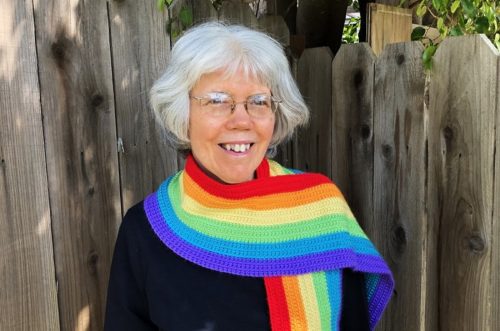
I am celebrating my birthday on Oct. 21 by re-posting this reflection on my coming-out story and life journey as a lesbian Christian. During my birthday month, I try to appreciate my own accomplishments and reflect on my dreams for the future.
My 2024 birthday wish: You are invited to donate to Q Spirit for my 2024 birthday. Say happy birthday with a contribution and help me promote LGBTQ spirituality!
I am what many believe is impossible
I am what many people believe is impossible: a lesbian Christian. I bring together two realities that appear to be opposites. I am too queer for most of the church — and too religious for most of the LGBTQ community. I am also an author, art historian, and retired minister in Metropolitan Community Churches (MCC). My specialty is writing about LGBTQ spirituality, with an emphasis on history, saints, books and the visual arts. Over the decades I have grown from serving a local congregation to being a “pastor to the pastors” who provides spiritual resources for LGBTQ people and allies all over the world. It is deeply rewarding to nurture artists, authors, scholars and spiritual seekers in many traditions worldwide.
I am a participant as well as an observer. I myself am an artist and creative writer, while at the same time I also nurture other authors and artists who make LGBTQ Christian imagery. I’ve been criticized harshly by religious conservatives for promoting LGBTQ spirituality . It’s a ministry that fits me well because of my background as a minister and an art historian.
My Christian faith gave me the strength to come out as a lesbian in 1985. Most people grow up Christian and discover they are LGBTQ. I am unusual because I grew up lesbian and discovered Christ. Raised mostly unchurched, I became an adult convert to Christianity. For me the obstacle was finding out whether God exists. As soon as I experienced God, I knew without a doubt that God loved all of me, including my queer sexuality. Christianity gave me a whole new way of looking at the world: I knew God loved me and created me as I am, so I could stop worrying about what others thought. I was no longer enslaved to social approval. My faith empowered me to come out as a lesbian, first to my family and then to others. Later I learned that my journey was rare. Many LGBTQ people start out feeling condemned as sinners by the church, and find liberation by rejecting religion. But I felt condemned by society and found liberation through the church. I could never imagine a God that didn’t totally love LGBTQ people.
1950s-70s in Iowa: Growing up
I was born on Oct. 21, 1957, and raised in Iowa in a mostly secular family. My mother was an artist and elementary-school art teacher who filled our home with art. She taught me to love art and to create it myself from the time I was old enough to hold a crayon. Coming from an elite background, my mom went to high school with First-Lady-to-be Jackie Kennedy. But at Oberlin College she fell in love with a World War II veteran who was there on the G.I. Bill. My father was a businessman and part-time professional musician. His Big-Band music formed the soundtrack to my childhood, and he taught me to play the Hammond organ as he did. The oldest of two children, I enjoyed many adventures growing up in the Iowa suburbs with my younger brother, Craig. We loved playing with rubber animal erasers, real live toads and the family dogs.

Kittredge Cherry, age 5, with the family dog. Watercolor portrait by her mother. Photo by her father, Arthur Cherry.
My family didn’t expose me to much religion. I was an un-baptized kid whose knowledge of Jesus was more or less limited to the “Jesus Loves Me” song and the Nativity scene that we set up at Christmas. Easter was all about bunnies and Easter eggs. My mother taught me the Lord’s Prayer, which is still the basis of my prayer life. She took me off and on to various Protestant churches, but God didn’t seem real to me back then. Adults talked about God at church, but their actions spoke louder than words and I came to the conclusion that they didn’t actually believe God was real. They told Bible stories in odd little snippets that made no sense to me, especially because the people in the scriptures had no connection to anything that I learned in my public school. Men ran the churches and starred in the Bible stories, and I felt left out as a girl, even before I knew I was a lesbian. Whenever a Biblical movie came on television, I would change the channel immediately.
I was aware of the larger world from an early age. I remember my joy on the day they taught us in school about the water cycle: That rain turns into rivers and then evaporates to become rainclouds again in nature’s endless bounty. As a fourth-grader I loved learning about the Native Americans and millions of buffalo who lived in Iowa long before me. My budding political awareness led to a fascination with the Kennedys. My best friends were two sisters, and we nicknamed ourselves after the Kennedy brothers. I was the youngest so I was called Teddy, while the sisters were John, for the former US president, and Bobby, for the presidential candidate. We played touch football in our backyards because that’s what the Kennedys did. I cried on June 6, 1968, when Robert F. Kennedy was assassinated — my political awakening at age 10. I was only a kid, but I marched in the Moratorium to end the Vietnam war in 1969 and picked up trash on the first Earth Day in 1970. I’m not sure that my parents even knew what I was doing.
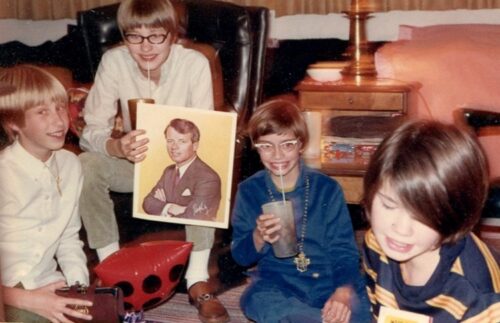
My friends gave me a portrait of Bobby Kennedy for my 11th birthday in 1968. I’m the girl on the right.
At the cusp of puberty, I was attracted to God and I was attracted to girls, not necessarily in that order. I also loved to write. I felt what I now know were spiritual longings, but the churches that I visited seemed to be more about socializing than spirituality. Disconnected from the official church, I learned the gospel by gleaning what I could from my cassette tape of the rock opera “Jesus Christ Superstar” and its musical cousin “Godspell.” I watched “Godspell” over and over when I was in high school as a volunteer usher on the Showboat Rhododendron in Clinton, Iowa. Looking back, I smile at my own naivete because I had a totally mixed-up idea of who was singing what, and yet the scripture-based words strengthened me.
1975-79: Love and study at the University of Iowa
I majored in journalism and art history at the University of Iowa, where I fell in love with Audrey Lockwood, my college sweetheart, life partner and spouse to this day. She is still the love of my life and we were finally able to marry legally in 2016 — almost 50 years later. It all began when I noticed an extraordinary person with a briefcase and short, red curly hair walking purposefully across the main lounge of Burge dormitory in August 1975. Burge, also known as “the Zoo,” was our new home as University of Iowa freshmen. Gazing at the handsome stranger, I thought happily to myself, “Finally — I’m attracted to a man!” Ha! I soon found out that She was a butch woman from Milwaukee majoring in political science.
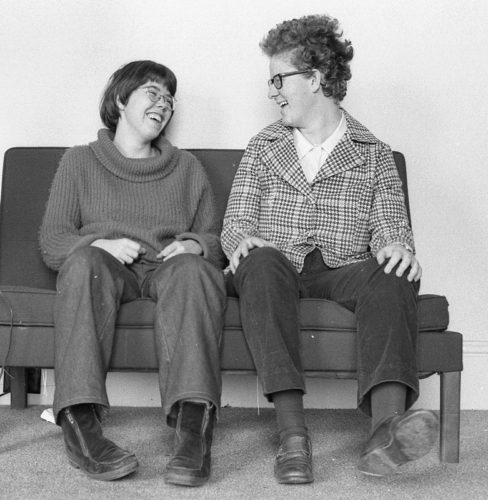
Kittredge Cherry, left, and Audrey Lockwood in their dormitory at the University of Iowa, 1978.
Audrey was passionate, intelligent and eager to make the world better. She dazzled me when she told me that she planned to be America’s first female president. The daughter of sophisticated journalists, Audrey had been a kind of child prodigy who used her winnings from a chess tournament to buy a pet armadillo. I had never met anyone like her. During college I got mundane summer jobs, writing for the local newspaper and welding refrigerator shelves at the factory where my dad was sales manager. Meanwhile Audrey flew to Washington for a glamorous internship at the U.S. Senate Select Committee on Small Business. It was the Watergate era and I was an idealistic young journalism student eager to follow in the footsteps of Washington Post investigative reporters Bob Woodward and Carl Bernstein. I am still inspired by their painstaking research and dogged determination to report the truth, even when it challenges the most powerful leaders.
Together Audrey and I made many friends among the international students, including some from a country that we both loved since childhood: Japan. One of her pet names for me was “Little Infidel” because I scoffed at religion. She, on the other hand, attended Mass every Sunday while the rest of our dorm slept, and that intrigued me too. Audrey and I stayed in the closet not because we thought homosexuality was a sin, but because we feared losing our families and job opportunities.
We graduated in 1979 during a recession, and jobs were hard to find. We mailed out tons of resumes to many places — including Japan. We both dreamed of making a dramatic move to Japan because of the opportunities there and our long-time love for the Japanese people and culture. Audrey quickly accepted a job offer from a corporate training program in Tokyo.
1979-80s: Journalism and Japan
It took me longer to find work. Finally, with a recommendation from Audrey’s father, I was hired as a daily newspaper reporter in the remote town of Quincy, Illinois. I spent three years covering business and the arts at the Quincy Herald-Whig. When I called to interview out-of-towners, they sometimes exclaimed, “You’re Kitt Who from the Herald-What?!”

Kittredge Cherry working as a newspaper reporter, circa 1980.
The editors lured me to Quincy by boasting that it was the biggest city in a 200-mile radius. True enough, but living in the isolated town of 30,000 was like going back in time. Quincy’s strait-laced establishment was shocked when I organized an art show that included a nude painting and wrote an article about the local male strippers. I also covered the devastating impact of the recession, a high-profile child-abuse murder and much more.
Herald-Whig regional editor Beth Keck had just returned from studying in China on a Rotary journalism scholarship. She encouraged me to follow in her footsteps. I joined Audrey in Japan by winning a Rotary International Scholarship for Journalists. I lived there for three years, studying at International Christian University in Tokyo and Kobe College (Kobe Jogakuin Daigaku). Those experiences led to my first book, “Womansword: What Japanese Words Say About Women.” It was not published until years later when I was back in the States, but then it became a surprise bestseller and even the New York Times praised its “very graceful, erudite” writing style.
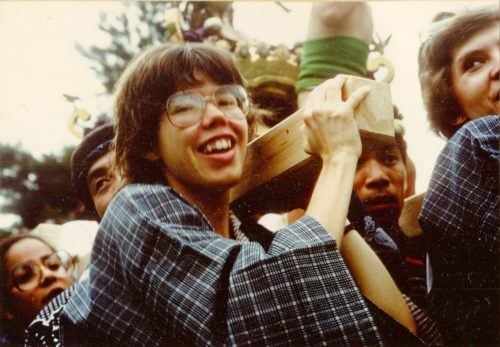
Kittredge Cherry carries mikoshi shrine in Japan, 1982.
My father’s death in 1983 threw me into a spiritual crisis. I was stunned when he died suddenly of a heart attack. I had only been to one funeral before in my whole life, when I covered the death of a Quincy politician as a reporter. My grief-stricken mind was searching for answers about what happens after death. I did not believe in life after death, and yet I could feel Daddy’s spirit as an ongoing presence. In shock, I resorted to church, specifically Kobe Union Church. It was an interdenominational English-speaking congregation with members from all over the world. There I felt God reach out to me, just as I am, lesbian and all.
1983-84: Finding God, getting baptized
I was sitting in a pew at the church in Kobe when I experienced a revelation that God is real. I was stunned when the congregation began singing “Nearer, My God, to Thee,” a hymn from my dad’s funeral. I was instantly convinced that it could not be a coincidence, but that this holy synchronicity was God reaching out personally to me — and accepting me just as I am, including my lesbianism. As soon as I knew there was a God, I knew that God accepted homosexuality because otherwise God would not have bothered with me. I had no trouble reconciling Christianity and homosexuality. It sounds simple when I retell it, but it was a joyful, life-changing moment of feeling fully loved and knowing that I would never be alone again because God is always with me.
Because I came from a fmostly secular family, it felt almost as transgressive to become a Christian as to be a lesbian. I grew up believing that some kinds of sexual attraction were normal, but any strong religious sentiments were always an embarrassment.
Kobe Union Church turned out to be a great place to find faith because it was (and still is) an interdenominational English-speaking congregation of people from Japan and all over the world. With so many different backgrounds, nobody tried to impose one rigid style of Christianity on the others. We were free to connect with God in our own way. I was following Jesus, but I saw Christianity as one of many equally valuable paths to God, including Buddhism, Shinto, and goddess worship. This diverse congregation included at least one other closeted lesbian, who became a spiritual guide to me. I also benefited from meeting one-on-one with pastor Jim Fiske.
I did object to Christianity’s oppression of women, but my eyes were opened by Japanese feminists, many of whom are Christian. They said that conversion to Christianity set them free from sexism. Raised Buddhist, they saw Christianity as a fresh, egalitarian religion that established schools for women, ended legal prostitution, and ordained Japanese women during World War II. After I started attending church, I learned that Jesus consistently defied the norms of his culture to empower women. He dared to love outcasts, including women, lepers and foreigners. I was impressed by Bible readings such as, “There is neither Jew nor Greek, there is neither slave nor free, there is neither male nor female; for you are all one in Christ Jesus.” (Galatians 3:28). I also poured over American Christian feminist writing, such as Virginia Mollenkott’s books and “Daughters of Sarah” magazine. Living in Japan, where only two percent of the population is Christian, afforded me a clearer view of Christianity’s value than I had in America. Japanese Christians are choosing to ignore or even resist the majority. That is subversive. The lack of social pressure to join a church freed me to make my own decision. I was baptized at Kobe Union Church in 1984 at age 26.
My baptism in Japan is an example of how lesbian sexuality and Christianity came together in my own life. I was not baptized as a baby, so I had to be baptized in order to join Kobe Union Church. My baptism ceremony was almost like a same-sex wedding. The church required me to have a sponsor stand beside me and promise to guide me in faith, so I chose Audrey Lockwood. Nobody else knew at that time that we were lovers, although some probably suspected. Audrey and I stood side by side before the altar as the pastor gave a blessing.
1985: Coming out, coming home
Christian teachings such as “the truth shall set you free” empowered me to come out as a lesbian the following year. Audrey and I revealed our relationship to family and friends. Later our parents accepted our relationship, but at first they were devastated. Coming out also meant coming home because we decided to move back from Japan to the States. We chose San Francisco as our new home because it had a strong gay and lesbian community as well as a large Asian population.
Brave or foolish or both, we thought it would be a great idea to take a do-it-yourself low-budget world tour on the way home, starting with China. We rode the cheap “hard sleeper” cars of the slow trains from Guangzhou to Xian and Beijing in 1985. China had just opened up to individual tourists from abroad.
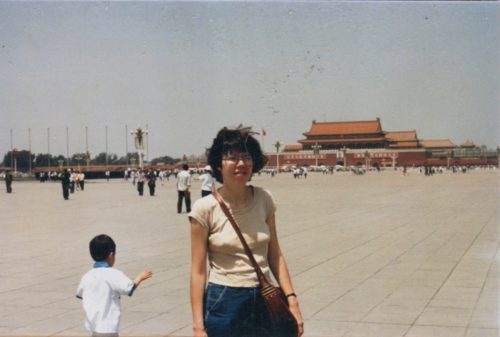
Kittredge Cherry at Tiananmen Square in Beijing, China, 1985. Photo by Audrey Lockwood.
Travel in a developing country was a shock and a daily struggle for food and shelter amid air pollution and unsanitary conditions. Everyone had a cough, but after a few weeks mine turned into pneumonia that was so severe that I had to spend a week in a Beijing hospital. Our fantasies of a world tour came to a screeching halt. Audrey helped me go directly from my hospital bed in Beijing to a plane bound for California. I still regret that we didn’t get to cross Russia on the Trans-Siberian Railway as planned. This experience ended up fueling my sense of gratitude, compassion, and desire to help others as a minster.
1980s-90s in San Francisco: Ministry, marriage and seminary
On our first Sunday in San Francisco, we decided to go to Metropolitan Community Church. MCC is a denomination that ministers primarily in the LGBTQ community. At that time it was one of the very few options then for Christians who were openly lesbian or gay. We were invited by Nancy Wilson, who later became my boss and moderator of the whole MCC denomination. Our friendship began when Nancy wrote to Audrey in Tokyo asking to subscribe to the “Feminist Forum” newsletter that she edited for International Feminists of Japan.
I felt nervous when I first opened the door to MCC San Francisco, the so-called “gay church” in San Francisco. We had never been to a Pride march. All I knew was that MCC was a church by and for the lesbian and gay community. (The term “LGBT” had not yet been coined, and “queer” was still an unredeemed insult.) I wasn’t used to being open about my sexual orientation. I didn’t know what to expect, but I sensed there was no going back. Immediately I was put at ease by the warmth of the congregation and the beauty of the rainbow flags hanging behind the altar and around the sanctuary. Two powerful clergywomen, Nancy Wilson and Coni Staff, both spoke. God’s presence was palpable. At last I was free to be fully myself, both lesbian and Christian.
Audrey and I went to our first Lesbian/Gay Freedom Day Parade in 1986. We planned to stay on the sidelines, not ready to go public as lesbians yet. But being there transformed us. Never before had we seen thousands of LGBTQ people openly celebrating who we are and how we love. When the MCC San Francisco group passed by us, we couldn’t resist. We spontaneously ran and grabbed the banner to join the march. You can see the joy on our faces. Free at last!
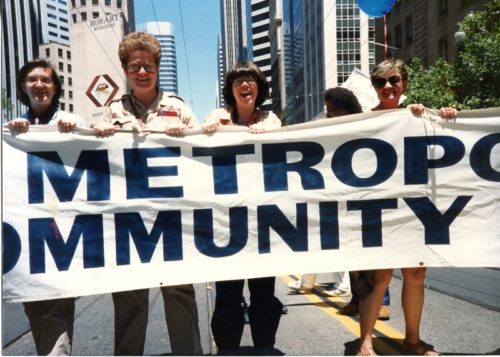
Kittredge Cherry and Audrey Lockwood carry an MCC banner at their first Pride parade in 1986.
Full of passion for God, I dove into study and ministry. I came of age spiritually with the help of an amazing congregation in the midst of the AIDS crisis. My ministry began during the AIDS pandemic of the 1980s at MCC San Francisco, located at 150 Eureka Street in a building that came to be known as “the pink and purple church in the Castro.” AIDS had a huge impact because our church was in San Francisco’s gay Castro neighborhood during the worst of the AIDS pandemic. At least two-thirds of the men in the congregation were HIV-positive, and members or their friends died of AIDS every week. Sunday worship was marked by tears, laughter and intense singing. We came to understand ourselves as a church with AIDS — catapulted into intense relationships, spiritual growth, premature death or all of the above. I feel that many of the friends who died at that time are still with me decades later as guardian angels or patron saints. My supervising pastor Jim Mitulski and I wrote a now-classic article about the experience for Christian Century in 1988: “We are the Church Alive, the Church with AIDS.” To quote author Charles Dickens, “It was the best of times, it was the worst of times.”
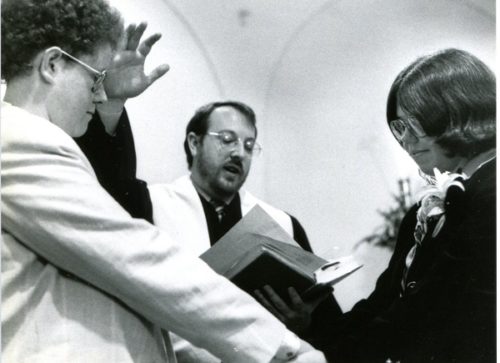
Holy Union wedding of Kittredge Cherry and Audrey Lockwood on April 11, 1987, with Jim Mitulski officiating. Photo by Lisa Wigoda.
In the midst of the pandemic, I also found new life. Audrey and I were united in a Holy Union church wedding on April 11, 1987 at MCC-SF. We didn’t wait for the government to approve our relationship — God and the church blessed us without all that. Less than a month later I led my first event at MCC-SF: a women’s spirituality speakers series with famous lesbian authors. Women’s participation tripled under my leadership. I organized the church’s first annual women’s retreat and was promoted to program director.

Kittredge Cherry appeared celebrating communion at MCC-SF on the front page of the San Francisco Examiner on April 16, 1990.
I was consecrated to professional ministry in a ceremony at MCC-SF on Aug. 6, 1989. Along with the usual vows to God and the church, I added a special vow to help the secular world too. This is not usually a concern for clergy, but it was for me. I still feel a special calling support people who are drawn to God but weren’t raised in the church.
I became a frequent worship leader and appeared on the front page of the San Francisco Examiner celebrating communion at MCC-SF in 1990. I went on to earn a Master of Divinity degree from Pacific School of Religion and be ordained by MCC. Theologians that I read in seminary made a lifelong impact on me. They include contemporary authors Carter Heyward, John McNeill, Henri Nouwen and Virginia Mollenkott and classic writers such as Julian of Norwich. During this phase of my life, I also wrote my coming-out guide, “Hide and Speak.” Meanwhile Audrey was a rare out lesbian working in the corporate world.
1990s in Los Angeles: International LGBTQ church leader
Audrey and I moved to Los Angeles in 1991 so I could take a job as ecumenical and public relations director for the whole denomination, advocating for LGBTQ rights at the national and international levels in every branch of Christianity. I had the privilege of working closely with MCC founder Troy Perry, a Pentecostal minister who was defrocked for being gay, and Nancy Wilson, who succeeded him as moderator of the whole denomination. Troy Perry calls me “Sister Kitt,” using the family language of his Pentecostal tradition. He was incredibly brave and visionary to create a church for queer people back in 1968, when homosexuality was still considered a sin, a sickness and a crime.
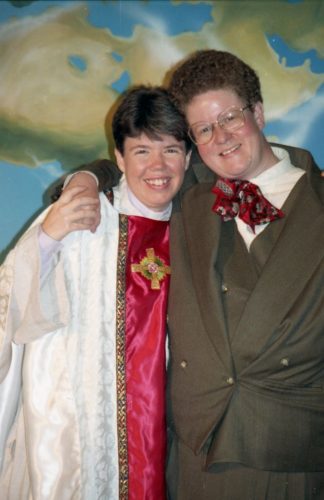
Kittredge Cherry at her ordination with spouse Audrey
I was on the forefront of the homosexuality debates at the National Council of Churches and World Council of Churches. Nancy describes some of our adventures at the World Council of Churches in her book “Outing the Church: 40 Years in the Queer Christian Movement.” She wrote about me in a chapter titled, “Gift Number 4, “Our Shamanistic Gifts of Creativity, Originality, Art, Magic, and Theater.”
In addition I organized dramatic demonstrations for LGBTQ rights in the church, including Hands Around the God-Box at the offices of the National Council of Churches and the take-over of the 1993 NCC meeting when members voted to deny observer status to MCC. I handled media relations for The Wedding, a spectacular group blessing of 6,000 lesbian and gay couples at the 1993 March on Washington for Lesbian, Gay and Bi Rights. For photos of these events and more, see my article Metropolitan Community Churches: Ministering in the LGBTQ community since 1968: Historic MCC photos.
While I was editor, the denominational newsletter “Keeping in Touch” was voted the most valuable MCC program. I co-founded a worship service in the style of Taize, an international ecumenical community known for its meditative chants. My soul and my theology were also nourished by women’s conferences such as Christian Lesbians Out Together (CLOUT) and Re-Imagining: A Global Theological Conference By Women: For Men and Women. Openly LGBTQ Christian leaders were a rare breed back then and we all knew each other. I had LGBTQ friends from a wide variety of Protestant, Catholic and Orthodox traditions, and gathered the best of their worship services into my book “Equal Rites.”
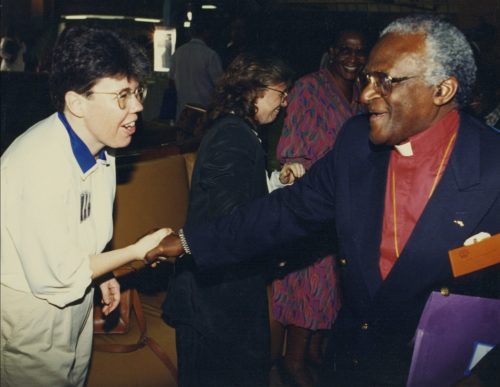
Kittredge Cherry shakes hands with Bishop Desmond Tutu, the Nobel Peace Prize winning human rights activist from South Africa, at the World Council of Churches meeting in Johannesburg in 1994.
I spent years promoting “dialogue” on LGBTQ issues at the World Council of Churches and. National Council of Churches (USA) as MCC’s ecumenical officer. It was exhausting and frustrating because they kept voting against us while creating “dialogue committees” over and over as a way to avoid making real change. Marriage equality, queer theology and ordination of openly LGBTQ clergy in some churches are all signs of progress. I still hope that all churches will move beyond “dialogue” to live out the Christian message that inspired and strengthened me to come out as a lesbian.
Recent times: Spiritual growth and online ministry
Suddenly Chronic Fatigue Syndrome forced me to leave my job and let go of my social life. I was forced into a much more contemplative way of being. Audrey, my hero, stuck with me. We expanded our family to include wonderful dogs and cats. My health kept me home most of the time, so I also tuned into the earth. Nature provided me with wisdom and companionship in my own backyard. I made friends with butterflies, moths, honeybees, crickets, spiders, fig-eater beetles, lizards and other small creatures living right outside my back door.
As my access to the outside world diminished, new spiritual dimensions opened to me. I felt that I had to pull out all stops and experiment with every theological concept and form of prayer in order to heal. I got startling results when I tried visualizing myself in “safe places” from childhood and inviting Christ to be there with me. I first learned that meditation technique during seminary, when a traditional male Jesus would walk politely next to me in silence. In the past others told me what Jesus was like. But they were all gone, and in my illness I was left alone with Jesus, unmediated. Now, in my imagination, a queer Christ sat down right beside me and invited me to walk with him through his “heart-memories.” We began what seemed like a guided tour through the Gospels, which I wrote about in my “Jesus in Love” novels.
My contemplative life as a writer reminds me of some women from my LGBTQ Saints series, especially Julian of Norwich and Hildegard of Bingen. Julian wrote her powerful “Revelations of Divine Love” while living alone in a cell attached to a church. It had windows so she could witness church services and interact with visitors. My computer screen became my window on the world and functions in much the same way.
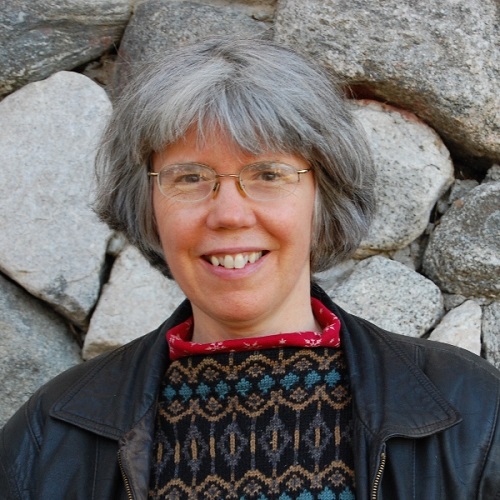
Kittredge Cherry with stone wall, 2009. Photo by Audrey Lockwood.
Slowly I began building a website, JesusInLove.org, based on the queer Christ. Then, by some grace, art caught up with me. My web designer told me that I needed images for my website, so I searched the Internet. It was hard to find any kind of LGBTQ-oriented Christ figures, but the rarest of all was the queer resurrection. I rejoiced when I finally came found “Jesus Rises” by Douglas Blanchard. It comes from his gay Passion series, which shows Jesus as a gay man of today in a modern city.
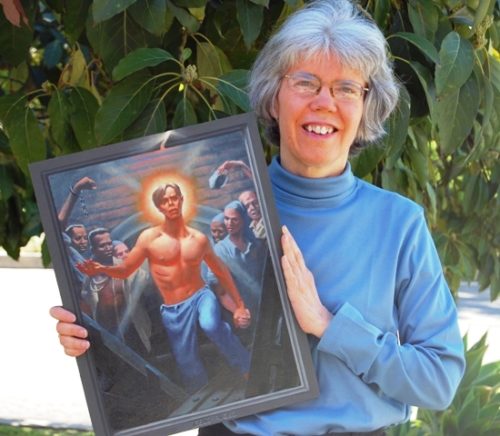
Kittredge Cherry with the original “Jesus Rises” painting from the gay Passion of Christ series by Doug Blanchard, 2013. Photo by Audrey Lockwood.
The new Christ images evoked a healing response in me. I was weaving together the separate threads of my life: spirituality, lesbian identity, writing, and art. My physical strength partially returned as I worked on my novels and began contacting the artists who seemed to have seen what I saw. Some let me display their work at JesusInLove.org. I aimed to promote artistic and religious freedom and show God’s love for all people, regardless of sexual orientation or gender identity. The website launch in 2005 sparked an explosion of interest. Hundreds of gay news sites covered my books and website, with blogs buzzing on both sides of the issue.
The response convinced me of the urgent need for my next two books, Lambda Literary Award finalist “Art That Dares: Gay Jesus, Woman Christ, and More” and “The Passion of Christ: A Gay Vision.” My unofficial online ministry grew to include Qspirit.net plus a popular blog and newsletter. I started the Santos Queer blog in 2012 to share my work in Spanish. In 2018-19 I expanded on social media by launching the LGBTQ Saints group on Facebook and inherited the role of administrator for the Queer Biblical Studies and Theologies group.
During this period I was also nurtured by the Arroyo Arts Collective, a local organization that honored my poetry, and United University Church, where music director Tom Griep set my words to song in an Easter anthem titled “Choose Life.”
I did not have much direct contact with the hateful side of Christian fundamentalism until I launched Jesusinlove.org. Most readers called my work inspiring, informative and “always fabulous.” But as soon as I put LGBTQ Christian content on the Web, right-wing Christians started bombarding me with hate mail. They threatened me with hell, labeled me “a hyper-homosexual revisionist,” and denounced my projects as “garbage,” “insanity,” and “a blatant act of defamation and blasphemy.” The ongoing religious bigotry proves that LGBTQ-affirming Christian voices are needed. LGBTQ spirituality is crucial because conservatives are using Christian rhetoric to justify hate and discrimination against LGBTQ people. Queer people have been labeled “sinners,” denied civil rights and economic access, erased from history, deprived of our holy icons, and sometimes beaten or killed in the name of Jesus. Much of the oppression is rooted in religion, so counteracting dangerous, hateful theologies is important even for non-believers.
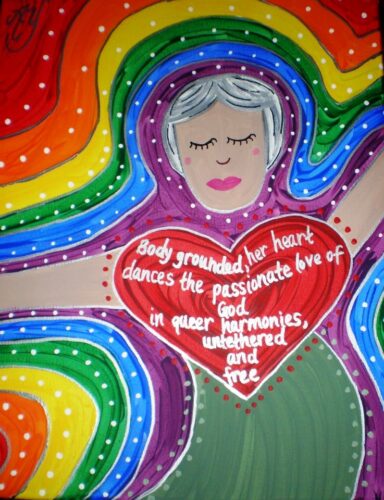
Portrait of Kittredge Cherry by Angela Yarber of Tehom Center, 2012
After decades of activism for LGBTQ rights and marriage equality, Audrey and I were finally able to marry legally on May 4, 2016 in a small, private civil ceremony at the Beverly Hills Courthouse. When we had our church wedding in 1987, we were both 29 years old. At the time there was no legal recognition for same-sex marriage or even for domestic partnerships. Pollsters were not asking about marriage equality yet. It took another 29 years for the law to catch up with their ground-breaking lesbian love.

Kittredge Cherry raises her hands in joy when the deputy makes the legal pronouncement that she and Audrey Lockwood are “spouses for life” on May 4, 2016 in the Beverly Hills Courthouse. Photo by Rodney Hoffman.
I was laser-focused on Jesus in the first years of my online ministry. Some readers convinced me to expand by telling me that they couldn’t relate to Jesus, but they liked the idea that LGBTQ people were among his followers. My LGBTQ Saints series launched in 2009 and quickly became the most popular content on my blog. I became an independent historian who applied journalistic skills to the past instead of reporting on current events. The queer saints fascinated me more and more as I dug into them. Working on each profile is like welcoming that saint as a houseguest. They never completely leave, and I sense that they surround me like “a great cloud of witnesses” (Hebrews 12:1). My spiritual journey began with being raised in a mostly secular family, so I did not grow up with saints. Still I have an inexplicable affinity for the folk devotion to saints as expressed from the grassroots by ordinary people. I feel it is possible to draw inspiration from this folk tradition while steering clear of the institutional church and its terrible policies on gender and sexuality.
I taught myself web design and built a site with a broader scope in 2016: Qspirit.net. It expands the meaning of holiness by presenting diverse saints, history and books of spiritual and religious significance to LGBTQ people of faith and allies. The Q in Q Spirit can stand for queer, questioning one’s own sexuality or questioning spiritual and religious traditions with quality content. My blog surpassed 3 million page views in its first 15 years. My most frequently cited blog posts include my LGBTQ Saints series, my Litany of Queer Saints, my gay Passion of Christ series, and the Rainbow Christ Prayer (co-authored with Patrick Cheng).
When I began putting together a bibliography of books that discuss my work, I was gratified to find a wide spectrum of publishers, both secular and religious, ranging from academic to mainstream. They were associated with both Catholic and Protestant traditions, including several different mainline denominations. It’s a true testament to my ecumenical experience and way of being.
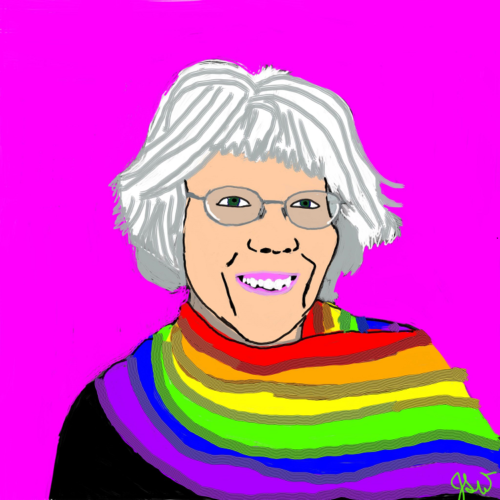
Portrait of Kittredge Cherry by Jeremy Whitner, 2022.
Researching LGBTQ saints taught me a powerful truth: Queer people have been spiritual leaders in every time and place. Our history is our power, but churches have tried to control people by burying queer history. We have to search extra hard for small clues — and make a big deal out of what we find — to compensate for past bias. LGBTQ saints show us not only THEIR place in history, but also OUR place — because we are all saints who are meant to embody love. Remembering our history and passing it on is a sacred responsibility that shapes the future.
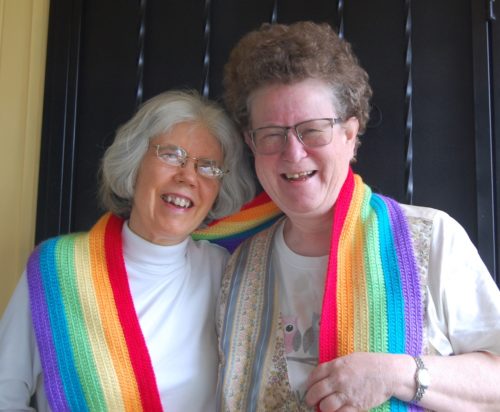
Kittredge Cherry and Audrey Lockwood share a rainbow scarf, 2020. Photo by Rodney Hoffman.
Some people are puzzled by my career path. At times even I find it hard to understand. The longer I live, the harder it is to remember and make sense of it all. Ultimately I have come to see that I consistently pursued truth, no matter where it took me. I began my work life as a newspaper reporter, digging out facts. Then I wanted to find out the reality of Japan and what the Japanese language says about women. Later I sought to discover deeper truths about life, death, love God and eternity.
I began chasing rainbows decades before they became an important part of my life as a symbol for the LGBTQ community. When I was a child, I liked the folk tale that there was a pot of gold at the end of the rainbow. I wasn’t sure that adults were telling me the truth when they said it was impossible to reach it. I tended not to believe what grown-ups said, and wanted to verify it for myself. I was a little girl when I took a long walk through a rainstorm in a serious effort to find the place where the rainbow touched the earth. Of course, I didn’t get there that day. But I am still reaching for the rainbow’s end.
Links related to Kittredge Cherry
About Kittredge Cherry page on Q Spirit
Bibliography of books that discuss Kittredge Cherry’s work
See photos of Kitt’s ministry in Metropolitan Community Churches
Historical articles document Kittredge Cherry’s LGBTQ ministry and activism
Kitt and Audrey reveal their love-letter postal art from the 1970s
___
Top image credit:
Kittredge Cherry with rainbow scarf. Photo by Craig Cherry.
___
This article was originally published on Q Spirit on June 3, 2021, was expanded with new material over time, and most recently updated on Nov. 11, 2024.
Copyright © Kittredge Cherry. All rights reserved.
Qspirit.net presents the Jesus in Love Blog on LGBTQ spirituality.


















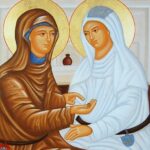
My journey withing the LGBTQ+ community predates Kittredge’s, but my encounter with her, originally through the “Jesus in Love” novels, was truly a landmark on my own spiritual journey. It is truly a blessing on top of many blessings that this lovely mini-memoir pulls a magnificent life of love and service into even greater clarity. Thank you for your sharing, my Spiritual sister!
Kittredge Cherry has become a revered member of Faithfully Yours Australia. Those of our LGBTIQA+ group here that alsoknow Kitt, will testify she is a blessing of love, caring, and sharing historical and current Christian information. She takes away human-induced discrimination and leads Christianity into the 21st century – with the absolute base of LOVE and no judgment.
Although Kitt & I have not met, our spiritual paths for social justice principles within Christianity are quite parallel. She long has been an author, journalist, minister, and fact-checking historian. She finds lost information and lays the foundation for future clear interpretations for gospels and sermons for multiple faiths.
Kitt is passionately committed to the Q Spirit newsletter and FB posts because it grew out of her own personal LGBTQ journey as an author, journalist, minister and historian. She has the most beautiful four and one-half decade relationship with her college sweetheart, life partner, and spouse Audrey (married 2016).
As Kitt says, “I bring a spirit of questioning authority and checking facts to my work. Q Spirit is a quest for spirituality beyond all boundaries.”
Thank you Kitt for your decades of social justice Christianity that not only fulfills one’s personal journey but brings thought-provoking love and peace to all around this world, including Australia. ❤
What a fantastic autobiographical pilgrimage! Having been “following” you now for quite some time, I finally have much more of the whole picture. Thank you and God bless you and your ministry.
What a wonderful story I have just read of Kitteredge Cherry. What an inspirational story.
The quest for Justice, Truth and Love continues for LGBTQI+ Peoples, Christians or not.
Thankyou Kitteridge, for all you have done and continue to do and for God, whose arms are wide enough to encompass us ALL.
Rosemary
Kittredge, your life story warms my heart. Thank you for opening yourself to God’s love and for sharing yourself in so many ways with all of us.